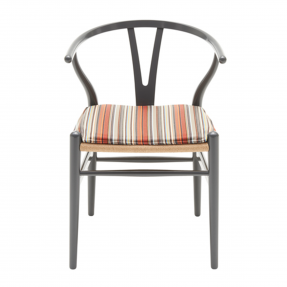The Wishbone Chair is perhaps Wegner’s most celebrated work. A light, attractive and comfortable dining chair with the characteristic Y-shaped back. The chair is a triumph of craftsmanship with a simple design and clean lines. Despite the chair’s straightforward appearance it takes more than 100 steps to make one. Amongst other things, the hand-woven seat consists of more than 120 meters of paper cord. Hans J. Wegner designed the Wishbone chair for Carl Hansen & Søn in 1949 and it has been in continuous production since 1950.
Hans J. Wegner is widely considered to be one of the leading figures in 20th century furniture design – and a driving force in the “Danish Modern” movement that changed the way people looked at furniture in the 1950s and 1960s.
British fashion designer Paul Smith has applied his iconic striped fabrics to a selection of furniture by legendary Danish designer Hans J. Wegner, which will be presented in Milan next month.
To celebrate the 100th anniversary of Wegner’s birth, Paul Smith picked his favorite pieces from those produced by Danish furniture brand Carl Hansen & Søn for the limited edition collection.
The Big Stripe and Stripes fabrics designed by Smith for American textile brand Maharam were used to upholster products including the Shell Chair, Wing Chair and Wishbone Chair, which were created by the Danish Modernist designer between the late 1940s and the 1960s.
Smith’s striped fabrics are woven from worsted wool in a range of colors and the two designs offer different densities of pattern. The Stripes pattern was designed in 2006, while the Big Stripe design launched last year.
Earthy tones characterize the Stripes fabric used to cover the seat pad of the Wishbone Chair from 1949.
designer: hans j. wegner, paul smith
producer: carl hansen & søn
period: 1949, 2014
introduced: 2014 milan design week








